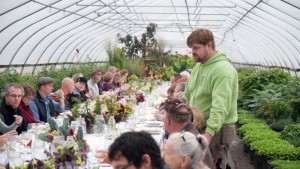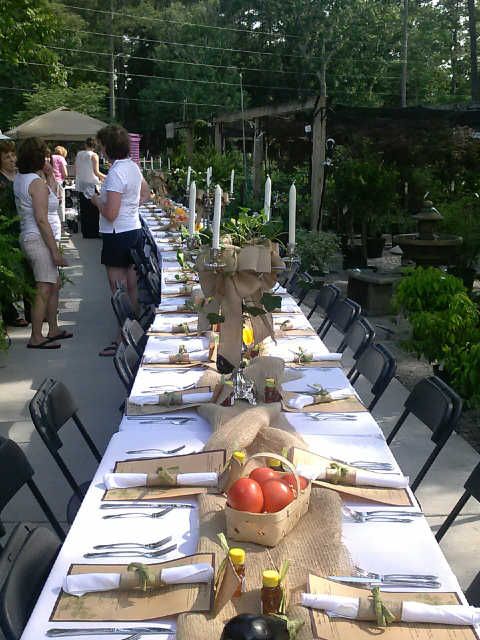How To Host A Spectacular Farm Dinner

Farm-to-table dinners are a great way to connect your customers with a love for nature and growing things.
These three green industry companies have had a lot of success with their farm dinners. Find out what it takes to pull one of these dinners off successfully.
Advice from Tangletown Garden’s Dean Englemann:
You have to be certain you’re matching the ticket price to the experience, make sure you’re exceeding expectations. It can’t just be about the food. You have to deliver the experience.
For us, we want to make sure there’s a lasting experience of connecting our food to families and dining. For lack of a better comparison, we want sitting in a field, eating food we grew and created, to be a religious experience. There’s almost a ceremonial aspect to these dinners.
We’ve always thought that the shortest distance between the earth and people is the distance between the hand and the mouth. There’s something symbolic and ceremonial about eating food grown only a few yards from where you are eating. You have to create a little of that for people who haven’t thought about it. They’re going to feel that energy. They’ll realize even if that’s not why they came, we’re participating in something greater than the actual act of having dinner.
We always start with a tour of the farm, to show how we do what we do, and why we do what we do. We let them see the farm, pulling back the curtain — we don’t hide anything.
When we start talking about why we select varieties for nutritional value, and we start talking about why do we eat, we emphasize the need to nourish the body. We nourish the soil and the farm, and that creates a plant or animal that has more nutrition. And we’re going to be sitting down in 40 minutes to enjoy food that has more nutrition. That’s further than most people go with it.
We don’t want them to just have an experience, but to take that experience home with them. We want them to start thinking about the food that they’re eating. So our chef will talk about why she coupled the food she did to enhance the most nutrition, and that’s why it will taste so great.
The dinner starts when it’s still light, and last through the evening to when it’s starting to get dark. We have fire works show every so often. That’s one of the unexpected things we can do.
The tour is so informative, almost mind blowing. We want to stimulate them on that tour. For most of our customers, they’re leaving the concrete jungle, and we’re giving them the chance to spend a few hours in the country. That event puts them in a different place mentally.
We try to keep it neat and tidy, but we could improve. The last thing we want is to have them think about is a really dirty pig pen or cow pen. We want them to see the lush green pastures. If they get to see them in there natural environment as much as we can replicate it. Yeah, I’m giving them a really wonderful life.
And we’ll make sure we dig things up, show them the beetle banks, and make sure they understand what we’re doing and how that makes healthy food.
I don’t have a problem with the organic certification process, but I don’t like the price being driven up, putting it out of reach of a lot of people who need it most. If you have any doubt, if you think we’re sneaking in, you can show up any time, and you won’t find anything that will worry you about the food we produce.
One of the things we do with the meal itself is we extend the menu beyond what we grow. We’ll invite local breweries or vineyards to come in, and we partner with other folks. During the happy hour, they have their own people there mingling with our guests. Each course of the meal, a glass is poured, either wine or beer..
We usually cap attendance at around 100. We don’t want it so big we can’t handle it, but we want a critical mass. Some of that might have something to have the facility. When you’re sitting in a 400-acre farm, 32 people can feel sparse.
Don’t over sell what you don’t have the capacity to manage, and don’t over sell the food if you can’t deliver. Everything has to be coordinated, and the administrative stuff before hand is actually more important than the work the day of.
Tips from Peace Tree Farm’s Stephanie Whitehouse:
The farm-to-table dinner has been so much fun here at Peace Tree Farm. The first year was a way to celebrate the opening of the Philadelphia Flower Show, whereas the dinner this year was a fundraiser event for the Pennsylvania Association for Sustainable Agriculture.
Here are some helpful tips for those who would like to repeat this event at their garden center, greenhouse, or farm are:
- Collaboration with local chefs and farmers is key to making the event feel authentic, genuine, and downright fun. Since Peace Tree’s expertise is NOT in cooking, having Eclectik Domestic handle the menu development, ingredient procurement, and cooking was a key to the event’s success. This year Katie Briggs of Eclectik Domestic signed on twice as many producers to participate in providing ingredients for the menu, some of whom had recipe ideas and all of whom attended one of the two dinners. She met with each and every one of the farmers well in advance to brainstorm menu options, and in some cases even had additional ingredients provided the week of the event based on their availability.
- Time Management is key, and allowing yourself plenty of time before AND after the event is important. Last year we had too many tasks that we left to the afternoon of the event. We also didn’t account for the amount of time it would take to transform the greenhouse from a supper club venue back to its regular “working greenhouse” state before Monday’s big shipping day. This year we planned the event so that it would NOT fall the weekend leading into the shipping for the Philadelphia Flower Show, and began set up two days prior so come Friday it was smooth sailing for the first dinner.
- Little details go a long way and are noticed by your guests. Menu cards for each place setting, candle light and twinkle lights for the tablescape and greenhouse, music to set an ambiance all help set the mood for the event and make it extra special.
- Flexibility is essential. Some guests might show up without RSVP-ing, while others may cancel at the last minute. Building flexibility into your table seating and event timing helps to make for happy guest and happy servers. Think of the event like a wedding –the guest will never know was originally planned but didn’t get done.

Wingard’s Market Farm Dinners
Think about the experience from the customer’s perspective, from the time they pull up to your place until they head home.
Make sure:
- There’s plenty of parking
- You limit attendance to keep it “exclusive”
- You clean the complex up; plated dinner
- There are linen table cloths and china, and crystal
- You have cookers, heaters, etc., to prepare the food
- You have some easy listening musical entertainment during cocktails
- You have the staff dress nice and consistent
- You use a good, reliable caterer with whom you can plan the menu; use local food (i.e., 200 mile radius from the business)
- You serve wine to compliment the menu
- You have a good rental company for tables, chairs, linens, glasses, china, silverware, etc
- If it’s outdoors, that you have access to fans
- You have an after dinner speaker (we used PBS garden show host, Agriculture Commisioner, Beekeeper, etc.) speak on a relevant topic










